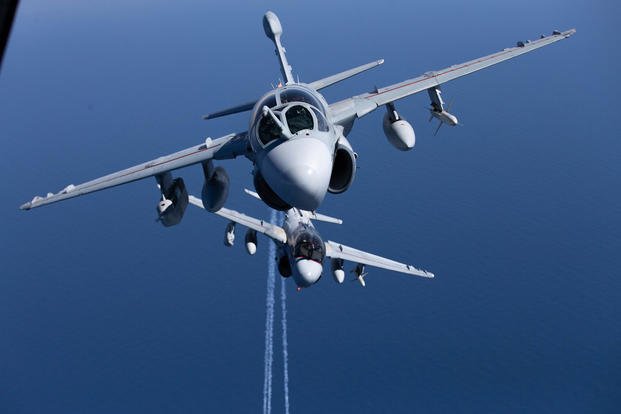The Marine Corps is deactivating its last EA-6B Prowler squadron this week, marking an end to 42 years of service for the electronic warfare aircraft.
Marine Tactical Electronic Warfare Squadron 2 will hold its deactivation ceremony Friday, officials announced Tuesday. The squadron was the last to fly the Prowler in combat, supporting troops who were taking on Islamic State group terrorists in the Middle East late last year.
Nearly 800 people are expected to attend Friday's ceremony as the last of the Prowlers prepares to head to the boneyard. Attendees will include past and present EA-6B pilots and crew members, said 1st Lt. Sam Stephenson, a spokesman for 2nd Marine Aircraft Wing.
The Prowler's mission is largely classified, but it's used to deny, degrade and disrupt the enemy's use of the electromagnetic spectrum. The aircraft has flown more than 260,000 hours since 1977.
Prowlers deployed with Marine squadrons more than 70 times to support every major combat operation, including those in Libya, Iraq, Afghanistan, Syria and Bosnia.
VMAQ-2 has been active since the Korean War, when it was called Marine Composite Reconnaissance Squadron 2. It was first Marine Corps squadron to transition from the EA-6A "Electric Intruder" to the EA-6B "Prowler" in 1977, a press release states.
Capt. Robert Ryland, an electronic countermeasures officer with VMAQ-2, told Military.com in November that it was "a great honor" whenever he got to fly in a Prowler.
"The Prowler has been a really incredible workhorse for the Marine Corps, the United States and allied forces for many, many decades," Ryland said. "I know the people who fly and fix these aircraft have a lot of respect for them and certainly for those who came before us. There is a tremendous amount of hard work and training that goes into performing the Prowler mission."
Despite the Prowler's retirement, the military's electronic warfare mission remains vital. The Marine Corps has developed new electronic warfare capabilities, including pods or sensors that can be affixed to fixed- and rotary-wing aircraft, along with new signals intelligence and cyber capabilities.
Three Prowler squadrons were deactivated ahead of VMAQ-2. In May 2016, Marine Tactical Electronic Warfare Training Squadron 1 -- the EA-6B Fleet Replacement Squadron -- deactivated. That was followed by VMAQ-4 in June 2017 and VMAQ-3 in May 2018.
Related Video:
-- Gina Harkins can be reached at gina.harkins@military.com. Follow her on Twitter @ginaaharkins.










